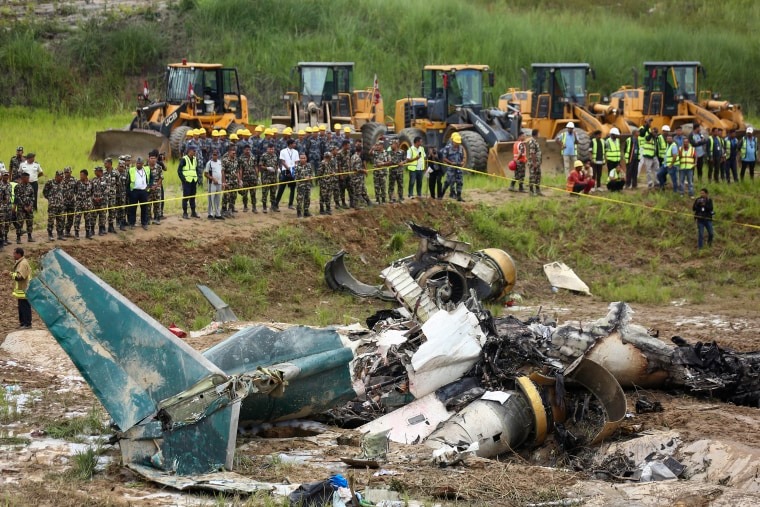Advertisements
Horrific Incident at Kathmandu Airport

KATHMANDU (Reuters) – In a tragic event on Wednesday, a regional passenger plane operated by Nepal’s Saurya Airlines crashed shortly after takeoff from Kathmandu’s Tribhuvan International Airport, resulting in the death of 18 people. The ill-fated aircraft, en route to Nepal’s newly inaugurated Pokhara airport for routine maintenance, burst into flames upon crashing, leaving the nation in mourning.
Details of the Crash
Flight Information and Immediate Aftermath
The aircraft, a 50-seater CRJ-200 with the registration 9N-AME, was carrying two crew members and 17 technicians, including one engineer from Yemen. According to the Civil Aviation Authority of Nepal, the plane veered off to the right and crashed on the east side of the runway shortly after takeoff.
“Shortly after takeoff … the aircraft veered off to the right and crashed on the east side of the runway,” – Civil Aviation Authority of Nepal
Rescue Efforts and Survivors
Tragically, only the captain survived the crash and is currently receiving treatment at a local hospital. Tej Bahadur Poudyal, the spokesman for Tribhuvan International Airport, confirmed the grim news, highlighting the severity of the incident. Television visuals showed firefighters battling the intense blaze, with thick black smoke billowing into the sky.
Eyewitness Accounts
Eyewitnesses reported seeing the plane flying just above the runway before tilting to its right and crashing. The charred remains of the aircraft were scattered across lush green fields, with rescue workers sifting through the wreckage and bodies being carried to ambulances as local residents looked on in horror.
Background and Aircraft Details
Saurya Airlines and Fleet Information
Saurya Airlines, established in 2014, operates two CRJ-200 regional jets, a model initially owned by Canada’s Bombardier but acquired by Mitsubishi Heavy Industries in 2020. The crashed plane was one of these CRJ-200 jets, and it was scheduled for a month-long maintenance at the new Pokhara airport, which is equipped with state-of-the-art aircraft maintenance hangars.
Advertisements
“The plane was scheduled to undergo maintenance for a month beginning Thursday … It is unclear why it crashed,” – Mukesh Khanal, marketing head of Saurya Airlines
Nepal’s Troubled Air Safety Record
Historical Context
Nepal’s aviation industry has long been plagued by safety issues, with nearly 350 fatalities resulting from plane or helicopter crashes since 2000. The country’s challenging geography, with its numerous remote airports nestled in mountainous regions, contributes significantly to the high risk of air travel. Nepal is home to eight of the world’s 14 tallest peaks, making navigation particularly treacherous.
The deadliest aviation disaster in Nepal occurred in 1992 when a Pakistan International Airlines Airbus crashed into a hillside near Kathmandu, killing 167 people. More recently, in January 2023, a Yeti Airlines crash resulted in the deaths of at least 72 people, a tragedy attributed to pilot error.
Recent Incidents
Nepal’s main airport, Tribhuvan International, is situated in the Kathmandu Valley and is surrounded by mountains, affecting wind patterns and making takeoff and landing hazardous. The aviation sector’s poor safety record has drawn international criticism and underscores the urgent need for improvements.
Response from Authorities and Industry
Official Statements and Investigations
Following the crash, Kathmandu airport was temporarily closed but resumed operations within hours. Saurya Airlines and the Civil Aviation Authority of Nepal have pledged full cooperation in the ongoing investigation to determine the cause of the accident. Bombardier, now MHI RJ Aviation Group, has been contacted for further information but has yet to respond.
Moving Forward
This tragic event highlights the persistent challenges facing Nepal’s aviation sector. As authorities work to uncover the cause of the crash, there is a renewed call for enhanced safety measures and infrastructure improvements to prevent future disasters.
Conclusion
The crash at Kathmandu airport is a stark reminder of the inherent risks associated with air travel in Nepal. As the nation grieves the loss of 18 lives, the focus now shifts to ensuring such tragedies are not repeated, with stringent safety protocols and better-equipped aircraft playing a crucial role in this endeavor.

